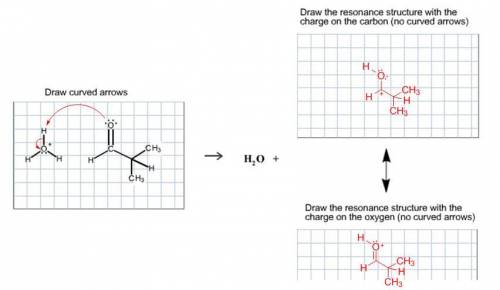
Chemistry, 19.07.2020 01:01 dontcareanyonemo
A proton transfer reaction can occur when a carbonyl compound is placed in an aqueous acidic solution. Water and a charged conjugate acid are produced. The resulting organic compound is resonance stabilized. Draw the curved arrows for the proton transfer and draw both resonance-stabilized organic products in the appropriate boxes. Be sure to include all lone pairs and nonzero formal charges. Do not draw the water product.

Answers: 3


Another question on Chemistry

Chemistry, 22.06.2019 01:30
The table lists pressure and volume values for a particular gas. which is the best estimate for the value of v at p = 7.0 × 103 pascals?
Answers: 3

Chemistry, 22.06.2019 02:00
The alkali metals (group 1) consist of lithium (3), sodium (11), potassium (19), rubidium (37), cesium (55), and francium (87). they are soft, metallic solids with low densities and low melting points. based on the data shown in figure 1, how many valence electrons do alkali metals share?
Answers: 3

Chemistry, 22.06.2019 05:40
Salicylic acid is a very important acid. it is used to synthesize the aspirin by treating with acetic anhydride. a 0.2015-g sample of salicylic acid was dissolved in a 100.00-ml volumetric flask, and the solution was diluted to the mark. a 10-ml aliquot of this solution was titrated with standard naoh (0.01130 + 0.2% n) to a phenolphthalein faint pink color end point at 19.81 ml. (a) (calculate the normality of the salicylic acid solution used in the titration. (b) assuming the salicylic acid is pure, what is the equivalent weight of the salicylic acid? practice problems for the final exam (continued) (c) (calculate the inherent error in the determination of the equivalent weight you calculated in part (b). use the following absolute errors in the equipment /glassware when calculating the inherent error. 5.00-ml pipet: + 0.02 ml 100-ml volumetric flask: + 0.08 ml analytical balance: + 0.2 mg 25-ml buret: + 0.03 ml
Answers: 2

Chemistry, 22.06.2019 12:30
Which element has the lowest electronegativity? calcium(ca) gallium(ga) selenium(se) bromine(br)
Answers: 1
You know the right answer?
A proton transfer reaction can occur when a carbonyl compound is placed in an aqueous acidic solutio...
Questions




Computers and Technology, 24.08.2021 20:20





World Languages, 24.08.2021 20:20

Mathematics, 24.08.2021 20:20






Mathematics, 24.08.2021 20:20

Mathematics, 24.08.2021 20:20

Chemistry, 24.08.2021 20:20

Mathematics, 24.08.2021 20:20

Social Studies, 24.08.2021 20:20





